 This information has been archived for reference or research purposes.
This information has been archived for reference or research purposes.
Archived Content
Information identified as archived on the Web is for reference, research or recordkeeping purposes. It has not been altered or updated after the date of archiving. Web pages that are archived on the Web are not subject to the Government of Canada Web Standards. As per the Communications Policy of the Government of Canada, you can request alternate formats on the "Contact Us" page.
History
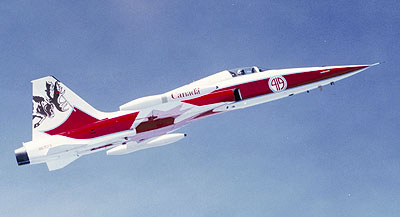
DND photo PCN77-118 CD 108 IMAGE 0056
Cold War Air Power Choices for the RCAF: Paul Hellyer and the Selection of the CF-5 Freedom Fighter
For more information on accessing this file, please visit our help page.
Introduction
History has not been kind to Paul Hellyer. Canadian airmen, in particular, have few good things to say about him. In addition to being responsible for ending the Royal Canadian Air Force (RCAF) as an independent service, Hellyer’s role in convincing his government to select the Northrop F-5 Freedom Fighter jet fighter and to kill the nuclear strike role in Canada’s overseas NATO Air Division was, as viewed by most airmen, unforgivable. This article will present an assessment of Hellyer’s motivation in recommending an aircraft that was clearly unpopular to most airmen, and one limited to a conventional role at a time when the Liberal Party had endorsed the use of tactical nuclear weapons for both the RCAF and the Canadian Army in Europe, and for the air defence of North America. Politics was certainly a factor in this decision. The purchase of what would, when built under license in Canada, become the Canadair CF-5, had more to do with associated industrial benefits and questionable government practices than with much consideration of operational capability. But there is more to this story. Hellyer’s choice of the CF-5 was driven, in part, by a personal interest in Canadian air power and how this military option could be applied best in meeting the country’s foreign policy goals.
This article will therefore focus more upon Hellyer’s views on the use of air power, and how those views impacted the selection of the Freedom Fighter, rather than upon the selection process itself. Moreover, the CF-5 selection needs to be placed within the context of the Canadian nuclear strategy of the day, and how it was influenced by the RCAF’s acknowledged strike role in Europe. Hellyer rejected this role, distrusted his airmen, and was driven by a policy that provided the country with an offensive air power capability that supported foreign policy options, other than those conducted in support of NATO, and what was then North American Air Defence Command (NORAD). In short, the CF-5 story is part of the larger one of Canadian air power in the Cold War, and its linkage to government defence policy. It is this writer’s contention that, for a Canadian politician, Paul Hellyer was uncharacteristically interested in, and knowledgeable about, air power, and how it could best serve Canada. His education in air power would come from two main sources: the Northrop Aerospace Company and Wing Commander (retired) John Gellner. Unfortunately for the RCAF, Hellyer’s education in air power came at the expense of the air force, and it fuelled his conviction that the RCAF should replace the nuclear role with a purely conventional role. It also led to the selection of a tactical fighter aircraft for which the Canadian military had little use.
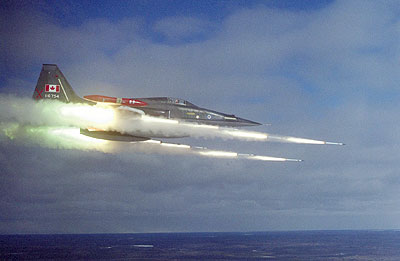
DND photo AEC82-168 by Sergeant Knox
A CF-5 test firing CRV-7 rockets on the Primrose Lake Evaluation Range near Cold Lake, Alberta.
Paul Hellyer and Air Power Theory
By the time Paul Hellyer became the Minister of National Defence (MND) in April 1963, he had established himself as an advocate of air power. It is not well known that Hellyer attended the Northrop Aeronautical Institute, pursuing engineering studies in California prior to the Second World War. Most interesting, in light of his preference for the CF-5 years later, was that at an early time in his life, he had established close ties with the future manufacturer of this fighter, while obtaining a formal air power education.1 On the other hand, Hellyer’s interest in the application of air power, and his high regard for the managers he encountered at Northrop, stand in stark contrast to the frustrations he experienced with the RCAF’s recruiting and training policies towards the end of the war. His wartime experiences left him with doubts about the ability of the armed services, particularly that of the RCAF, to support a national defence policy, due to their parochial service interests.
Paul Hellyer questioned the RCAF’s preoccupation with fighters generally, and he rejected the need for and the utility of the nuclear strike role specifically.2 He appreciated the importance of air superiority, but he did not share the views of senior Canadian airmen that this role was of paramount importance. He was also suspicious of the RCAF’s penchant for the procurement of offensive weapons systems during periods of fiscal austerity that came at the expense of other air power capabilities.3 Hellyer appreciated the inherent mobility and flexibility air power offered the armed forces and the nation in general, but he distrusted senior airmen, and the advice they were providing him.
In his biography, Hellyer relates a story regarding the state of the C-119 Boxcar transport aircraft that occurred not long before the CF-5 selection process. He was unconvinced by the RCAF’s position, supported by the Chief of the Defence Staff (CDS), Air Chief Marshal Frank Miller, that the Boxcars simply required a fleet maintenance overhaul, as opposed to being replaced. While on business in Toronto, he visited the de Havilland plant where the overhaul work was being conducted, and discovered that the aircraft were in a much worse condition than he had been led to believe by his uniformed staff. Eventually, he terminated the overhaul of the C-119s, and directed the armed forces to purchase 16 additional C-130 Hercules transport aircraft.4
Hellyer’s visit to de Havilland, and the subsequent decision to buy more C-130s, was motivated by his suspicion of RCAF motives, and its obsession with procuring fighter aircraft at the expense of other capabilities. His views on air power were shaped by his belief that the Canadian military had to move away from the narrow concept of nuclear war, and accept the premise that the specific concept of Mutual Assured Destruction (MAD) rendered the strategy of Massive Retaliation (MR) obsolete. Hellyer wanted Canada’s armed forces to concentrate on building up conventional forces that included a strategic sea and airlift capability in order to provide them with maximum flexibility and mobility.5 From the time that the previous Conservative government announced the purchase of the CF-104 Starfighter, and first alluded to a nuclear strike role in July 1959, Paul Hellyer’s goal was to rid the military of this aircraft, and, along with it, the nuclear role.6
While a member of the official opposition, and also while serving as MND, Hellyer conferred with the former RCAF senior officer and writer of military affairs, John Gellner.7 Hellyer’s views on air power, and, in fact, those of the Liberal Party policy-makers, were strongly influenced by Gellner. On 21 December 1962, Gellner wrote a letter to Hellyer in which he expressed his views on Liberal defence policy. Most interesting, in light of Liberal Leader Lester B. Pearson’s announcement weeks later that he would commit his party to nuclear weapons if elected, Gellner advised the Liberal Party to meet Canada’s alliance commitments initially, and to accept tactical nuclear weapons for its air and land forces in NATO, but then to move quickly to divest itself of them.8 These same views were expressed by Hellyer at a speech made at Walkerton, Ontario, weeks earlier on 8 December, the major exception being that he did not mention withdrawing nuclear weapons after the Liberals committed to them. Hellyer stated afterwards that he passed the contents of Gellner’s letter to Pearson on 31 December, with the obvious intention of bolstering his own position, knowing that “Pearson had more respect for Gellner’s views [on defence] than mine.”9
Clearly, John Gellner’s views on defence, particularly those with respect to nuclear weapons, shaped, if not determined, the path that Hellyer, Pearson and the Liberal Party followed upon assuming power in April 1963. Gellner was completely against the nuclear role for the CF-104, and, like the Minister of National Defence, was adamant that the Air Division should be relegated to a purely conventional mission. Gellner praised the Liberals’ policy statement, as expressed in the 1964 White Paper that emphasized conventional and mobile air power in support of global United Nation (UN) missions.10 However, the suggestion that the RCAF should rid itself of any nuclear role and the implication that the RCAF should abandon this air power role in NATO, was anathema to senior Canadian airmen, who recalled Pearson’s earlier election campaign promise to commit to nuclear weapons for the Air Division in Europe.
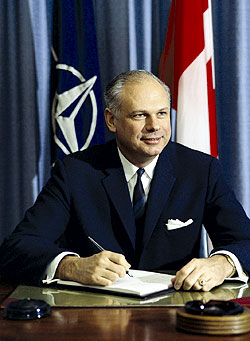
DND photo CFC66-11-3
The Honourable Paul Hellyer, Canada’s Minister of National Defence, 1963-1967.
Gellner did not endear himself to many Canadian airmen with the publication of his views in Canadian Aviation magazine in May 1964. Therein, he advocated replacing the strike role with a conventional role, and also suggested that pilots in the Air Division were not happy with their nuclear mission. He wrote that RCAF morale was at a low ebb, partly because its pilots in the Air Division, still waiting for their nuclear weapons, were asking themselves “what possible purpose were [they] serving when shadow-boxing in Canadian skies or learning to drop tactical nuclear weapons in Europe?”11 It is interesting that Hellyer made a virtually identical comment in his biography, stating that during the lead-up to the strike role, when the Conservatives were still in power and had not yet authorized the potential use of nuclear weapons, Air Division pilots “...were so ashamed they avoided bars frequented by their NATO colleagues.”12 Veteran strike pilots interviewed by this writer declared, however, that they were always committed to the strike role, and that any frustration on their part was generated by the political uncertainty demonstrated by both the Liberals and the Conservatives with respect to governmental commitment to the nuclear role in Europe.
The Minister’s approach to air power was part of a larger goal to integrate and unify the Canadian armed services. On 1 August 1964, a single Chief of the Defence Staff (CDS) replaced the three service chiefs and the Chairman of the Chiefs of Staff Committee, the objective being to bring the armed forces under more centralized control, with only one senior military officer reporting directly to the MND. With the loss of the Chief of the Air Staff position, and with the direction over air operations and logistics support respectively now becoming the responsibilities of the Vice-Chief of the Defence Staff and Chief of Logistics, the RCAF had lost a considerable amount of the political and military clout that it had possessed since the beginning of the postwar period.13
The Search for a Tactical Air Support Fighter
The search for a conventional role fighter aircraft, and the subsequent decision to purchase the CF-5, need to be understood within the context of Liberal Party policy with respect to their commitment to the nuclear strike role in Europe, and to the creation of an integrated military command structure, which was to be established on 1 June 1965. Liberal policy on the future of combat air forces for Canada’s armed forces was detailed in the 1964 Defence White Paper. As stated earlier, the emphasis was placed upon the need for mobile, tactical fighters that could perform conventional ground attack and surveillance roles.14 The RCAF had been tasked to review its aircraft requirements during preparation for this new defence policy statement. Later, on 4 August 1964, Hellyer directed his military staff to carry out a cost effectiveness study of known tactical fighter aircraft, and to make recommendations for an aircraft that would best meet the Liberal government’s air power criteria. What ensued was a selection process that put Hellyer at odds with his CDS, the RCAF, and, to a lesser extent, with senior public servants in the Department of National Defence (DND) and the Defence Production community.
In a memorandum to the MND dated 14 September 1964, Air Chief Marshal Miller echoed the views of the RCAF by strongly recommending that DND select the McDonnell Douglas F4C Phantom II aircraft from the list of tactical fighter aircraft under consideration.15 Of interest, but perhaps not surprising, given Hellyer’s years as Associate Minister in DND during the late 1950s, Miller tried to persuade his boss, based upon economic as opposed to operational grounds. Quoting the views of the Minister of Defence Production, Bud Drury, Miller pointed out that selection of a fighter aircraft needed to maximize employment in the Canadian aircraft industry. He brazenly suggested that the government order 108 Phantom IIs, and added that costs could be mitigated by taking advantage of an offer by the British government for a joint British-Canadian program to build the F-4 under license in Canada with Rolls-Royce Spey engines.16 These aircraft, powered by the British engines, were highly sought after by the Royal Navy. Miller and the RCAF clearly favoured the F-4 as a replacement for the CF-104 Starfighter, and for the CF-101 Voodoo air defence interceptor, but the CDS knew he had to justify the choice based more upon national industrial benefits than upon operational needs. “Selection of a cheaper aircraft than the F-4 would ease our financial difficulties but would not seem to assist Mr Drury in solving his problem (that of maximizing national aircraft production and employment.)”17
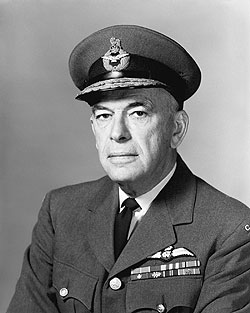
DND photo RE66-1426-1
Canada’s first Chief of Defence Staff (CDS) after unification, Air Chief Marshal Frank Miller, 1964-1966.
As is implied in his biography, Hellyer initially accepted Miller’s recommendation with respect to the F-4 because it was a suitable replacement for both the CF-104 and the CF-101 fleets, in addition to being suitable for a conventional attack role.18 However, he later concluded that this aircraft was unacceptable for the same reason it had been earlier rejected in 1959 as a replacement fighter for the F-86 Sabres and CF-100 Canucks of the Air Division – namely its prohibitive cost.19 Even pressure from senior members of Defence Production, who were as supportive of the joint Anglo-Canadian F-4 program as the CDS and the RCAF’s senior leadership, could not convince Hellyer to buy the Phantom II. As will be explained later, the MND’s options were clearly somewhat limited, given the direction of the incumbent Finance Minister, Walter Gordon. But Hellyer’s own actions indicate that his rejection of the F-4 was based as much upon his views about the air power needs of the RCAF as they were upon financial grounds.
There were two issues in Miller’s memorandum that ran counter to Hellyer’s views on Canada’s air power needs. First, the CDS once again unequivocally endorsed the demands of his old service for an expensive, multi-role fighter aircraft, instead of a less sophisticated but less expensive option designed exclusively for the conventional ground attack role. Second, Miller’s recommendation of the F-4 was to come at the expense of purchasing the de Havilland Caribou II medium transport aircraft. These aircraft were considered highly suitable for support of UN missions, a role that had been placed at the top of the Pearson government’s defence priorities. Equally important for Hellyer was that the Caribou was built by a firm located near his political riding in Toronto. If Hellyer had any faith left in Miller’s competence and his ability to remain unbiased in his role as the senior uniformed member in an integrated armed forces following the C-119/C-130 incident earlier in the year, this remnant of trust ended with the Miller’s subsequent recommendation to buy a high-priced fighter at the expense of yet another transport aircraft.
Hellyer’s next challenge was to mitigate any political fallout generated from not endorsing the popular F-4 Phantom II. He told Cabinet that a better opportunity to purchase this fighter had been squandered by the previous Conservative Government in 1959, when they decided to buy the CF-104 as a replacement aircraft for the Air Division. A subsequent 10-year financial commitment to the Starfighter left the Liberals no defence funds for the Phantom. In addition to attributing the existing poor financial state of DND to the Conservative’s decision to buy the CF-104, the MND also had to overcome the aforementioned strong lobby by the RCAF and the aircraft industry, which he felt were one and the same, to acquire the Phantom II. Hellyer would overcome these pressures, exerted by both the RCAF and from those within his own Party, by presenting the options before Cabinet in such a manner that he knew the outcome would go his way.
Hellyer offered Cabinet two options. They could either approve $215 million for the acquisition of six to eight squadrons of ground support aircraft, or they could approve an annual increase in the DND estimates of four per cent for the five-year period 1965 to 1970 if they insisted upon the acquisition of the F-4 RN (Royal Navy) for industrial reasons.20 Hellyer knew perfectly well that the latter option was not an option for a department that was already struggling to find funds to meet existing capital programs. He also knew that the senior officers representing the army and navy would not approve an expensive air force project that would have jeopardized their own acquisition priorities.21
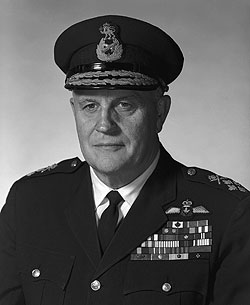
DND photo REP68-758
General Jean Victor Allard served as CDS from 1966-1969 after Frank Miller.
Notwithstanding Hellyer’s aggressive stance, it is important to understand that the Liberal government’s deliberations over defence were not entirely driven by the personal wishes of the Minister of National Defence. An important factor in his search for a cost-effective fighter aircraft was the insistence by Finance Minister Walter Gordon that the annual defence budget was to be held at $1.5 billion annually for three years. This ceiling was to be maintained in spite of Cabinet’s 1964 decision to increase the defence budget to an annual $2 billion, as recommended by the Conservative administration in March 1960. At the time, the increase was deemed necessary to pay for Canada’s increased commitments in support of NATO’s nuclear strike capability, as articulated in the Military Committee’s policy document (MC 70).22
In a memorandum dated 20 October 1964, Hellyer gave the CDS and the RCAF a strong indication that the F-4 would likely not be a fighter aircraft contender. The air power priorities for the new fighter were to be limited to the following conventional roles: close air support, interdiction, and reconnaissance. Furthermore, the potential areas of operation for this fighter, as documented by the MND, were to be those supporting United Nations missions, not taskings with NATO or NORAD.23 By 8 December 1964, Cabinet had not reached a conclusion concerning the future aircraft needs of the RCAF, but they did agree that the F-4 did not fulfill aforementioned force requirements. The next day, Prime Minister Pearson informed his British counterpart, Harold Wilson, that a deal for the joint production of the F-4 was off. And with this action, the opportunity for the RCAF to buy what would turn out to be one of the most successful and versatile combat aircraft produced in the West during the Cold War era evaporated. It also opened the door for the eventual acquisition of the CF-5.
In another memorandum dated 7 January 1965, Hellyer informed Miller of the Cabinet decision not to buy the F-4, and, further, that Cabinet had agreed to pursue a less costly tactical fighter, limited to close support of ground forces and one of lower performance than the Phantom II. The MND confirmed the government’s allocation of $215 million for a light attack aircraft that would best meet the government’s policy of “more balanced forces for employment in limited conventional war situations.”24 Furthermore, tactical fighters were no longer to be considered as replacements for the Starfighter and Voodoo fleets. Other than the now-eliminated F-4 Phantom II, the remaining light attack aircraft contenders under consideration were all American-designed aircraft: the McDonnell Douglas A-4E Skyhawk, the Grumman A-6 Intruder, the Vought A-7A Corsair, and the Northrop F-5 Freedom Fighter. Since much of the preliminary evaluation of these aircraft had already been completed, the CDS was tasked to provide his final recommendation by 15 February 1965.
Hellyer’s direction to his CDS notwithstanding, his memorandum included the assertion that “subsonic airplanes provide a higher cost-effectiveness ratio than supersonic on a basis that higher numbers of subsonic machines built for a given cost have better penetration possibilities than a small number of supersonic aircraft.”25 The MND apparently defended this simplistic and misleading conclusion, based upon an obscure US Navy study. Whatever the source, it did not originate from within his department. In fact, it became one of several instances whereby Hellyer, the civilian, was dictating to his military professionals, rather than requesting their advice on operational matters related to air power doctrine. He was determined to push through a tactical fighter that would be limited to the conventional role, and, simultaneously, to move the RCAF out of the nuclear strike role in Europe.
The Royal Canadian Navy (RCN) was quite interested in the A-4E Skyhawk. Naval aviators had been looking at this aircraft as a replacement for their aging McDonnell Banshee fighters that had ceased flying off HMCS Bonaventure during the autumn of 1962.26 Unfortunately for the navy, Hellyer had no intention of replacing its two fighter squadrons. The short, six-year Canadian service life of the Banshees was to mark the RCN’s first and last experience with carrier-launched jet fighters. In any event, on 15 February 1965, the Chief of Operational Readiness and a future CDS, Lieutenant-General Jean Victor Allard, sent his staff’s recommendations to the MND through the CDS. They had concluded that the A-7A Corsair was the best option, but, most interestingly, of all four options, only the F-5 was rated as not being suitable at all.27
In his biography, Hellyer’s description of the F-5 as “little more than a trainer with guns hung on it,”28 suggests that he agreed with the assessment of his uniformed staff. Yet his subsequent actions would clearly demonstrate his stubborn determination in guaranteeing that the CF-5 be selected as the new tactical fighter, and that the RCAF was to adopt an affordable aircraft capable of performing a conventional attack role.29 In a manner reminiscent of events leading up to the more recent selection of the Sea King replacement, Hellyer directed the military requirements staff to ‘amend’ the selection criteria. This action clearly placed the CF-5 in a more competitive position. He also instructed the Minister of Defence Production, Mr. Drury, that his staff was not to deal directly with the RCAF.30 In fact, Hellyer worked more closely with Drury and his staff during the selection process than with his own deputy minister, Elgin Armstrong. In an interview with Douglas Bland in 1994, Hellyer said he suspected Armstrong, because he “owed his job to Frank Miller, [and that] Miller encouraged the deputy minister to thwart his boss’s direction.”31
In a memorandum to the CDS dated 27 May 1965, Hellyer outlined new criteria for consideration in the selection process. He reduced the need for rapid deployment, and raised the possibility of deploying the aircraft to NATO’s flanks (meaning Norway or Turkey), as opposed to the Air Division’s area of operations. This was clearly a concession to the CF-5’s inability to survive the more sophisticated, integrated air defences of Warsaw Pact forces that were confronting NATO in the primary central European theatre. The new tactical aircraft was to have a decent air fighting capability when pitted against the MiG-19 Farmer, at a time when the standard fighter equipment of the Warsaw Pact was the MiG-21 Fishbed. In fact, by 1965, Fishbeds were already equipping potentially hostile air forces in the Middle East, as well as that of North Vietnam. Not only was the CF-5 unsuitable for the tactical environment of central Europe, it was incapable of meeting the even lower combat requirements of a UN mission. Unfazed by these facts, Hellyer insisted that the RCAF obtain a minimum of 108 aircraft for the $215 million, thereby artificially narrowing the selection process even further in favour of the less-costly CF-5.32
At this point, it was apparently clear to the uniformed staff that any subsequent recommendation other than the CF-5 was futile, and so, in a suppressed manner of protest, they simply submitted their final results to the Minister on 7 June 1965 without a recommendation.33 The following month, on 15 July, following Cabinet approval, the MND announced that the government had approved the purchase of the CF-5. Hellyer had succeeded in getting his preferred fighter aircraft. The Liberal Party had also achieved a victory in sustaining the employment line at Canadair in Montreal for production of the airframes, and Orenda Engines in Toronto, where the General Electric powerplants would be manufactured under license. Lastly, Mr. Drury met the requirements of the Defence Production Act in being at the time to retain a national aircraft production capability, by virtue of the license-built manufacturing agreement.34
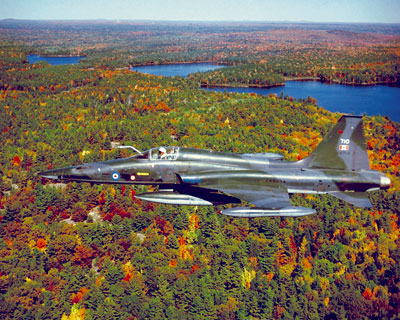
DND photo PMRC90-177 CD 015 IMAGE 0065
Air to air view of CF-5 Freedom Fighter from 434 Squadron in an autumn setting.
To what extent this selection was owed to Hellyer’s close ties to T.V. Jones, President of the Northrop Corporation, is unclear. But it has been suggested by someone close to the negotiations that this relationship was, indeed, a factor. The main reason Northrop won the tactical fighter contract was its offer to permit the Canadian government to sell the CF-5 to third parties. This was exactly what the Liberals accomplished. They eventually sold the CF-5 to the Royal Netherlands Air Force, providing Canadair and Orenda ultimately with a production program of 220 aircraft and the concomitant jet engines.35
The problem for DND was that the procurement decision had been made prior to the determination of aircraft specifications for the budget allocation of $215 million. Moreover, notwithstanding the politics of this acquisition, the reality for the Canadian armed forces was that the CF-5 had far too many operational limitations to be employed as a modern tactical fighter. Air Chief Marshal Miller identified these issues in a memorandum to the Deputy Minister (DM), dated 8 July 1965. In a nutshell, Miller reminded the DM that the CF-5 was an ineffective air superiority fighter because it lacked radar, and that it was an equally ineffective ground attack aircraft, because it lacked range when carrying any significant or useful weapon load.36 By February 1966, Northrop and Canadair determined that 90 aircraft could be produced for the money budgeted and the specifications demanded by the RCAF. On 20 April, Hellyer insisted that 115 aircraft be built for the $215 million. The consequence of this direction was an aircraft configuration, already of questionable operational value, being lowered even further through the deletion of manoeuvring flaps, an anti-ice windscreen, and a full navigation system.37
Hellyer’s Force Structure and Conventional Air Power
Another public promise made in the 1964 White Paper on Defence was to make changes to the command structure of the Canadian armed forces. It was perhaps the creation of Mobile Command that best illustrated Hellyer’s defence priorities. Its stated mission was “to maintain combat-ready land and tactical air forces capable of rapid deployment in circumstances ranging from service in the European theatre to United Nations and other peacekeeping operations.”38 By 1966, Hellyer emphasized that a vital component of the air force was to be its tactical air element. Not surprisingly, the planned aircraft to equip four tactical ground support squadrons was the CF-5. On the other hand, when the MND mentioned the strike role in Europe, he made it known that the CF-104s were also being readied for a conventional bombing capability.39 Conceptually, neither the CF-104, nor the strike role it was assigned, had any place in Hellyer’s desired force structure.
From the RCAF’s perspective, this did not bode well for the future of the Air Division, since Canadian airmen linked their existence in Europe to the nuclear role. They feared that replacing the Starfighter with the much less sophisticated CF-5, and being confined to a conventional attack role, would have removed the rationale for maintaining an autonomous Air Division. It was the view of line RCAF pilots, one that was supported by higher headquarters staff later on, that the Canadian-built CF-5 lacked the requisite all-weather navigation and attack capabilities to overcome the known enemy defences in the Central Region.
Hellyer has left no official correspondence suggesting that he ever considered replacing the CF-104 and the nuclear strike mission in the Air Division with a conventional attack-mandated CF-5 force. But airmen were suspicious that this was, in fact, what their MND had in mind at a time when the Air Division in Europe had just established eight CF-104 squadrons, equipped for a nuclear strike and reconnaissance role. The announcement to move to a conventional attack role in the 1964 White Paper on Defence trumpeted a limited duration for Canada’s nuclear role in Europe. Another strong indication that the nuclear role would not last long was the MND’s announcement that attrition replacements for the 238 CF-104s would not be procured.40
It is difficult to justify the actions of Hellyer and his peers, given that the Liberal government had, in effect, declared its intention to allow the Air Division to gradually decline. And this was less than a year after it had promised the Canadian electorate and NATO that it was going to honour its alliance commitments, including the use of tactical nuclear weapons. In his biography, Hellyer argues that this decision was consistent with the new American nuclear strategy of Flexible Response, by which an increase in NATO’s conventional capability would raise the nuclear threshold. Naturally, not all NATO member nations agreed with this assessment.41 Yet, the MND’s debatable intentions in this matter notwithstanding, there were some mitigating factors.
When the Vice-Chief of the Air Staff, Air Vice-Marshal Clare Annis, directed the Air Staff to come up with an implementation plan for a conventional role in the Air Division by 1966, he understood that the MND’s objectives in replacing the Starfighter’s nuclear role with a conventional one were, at least partially, a result of internal and external political pressures that could not be ignored. These included the conflicting government objectives of initially meeting the country’s nuclear commitments to NATO, followed by a plan to divest itself of them. Furthermore, pressure was being exerted on Canada by the American Secretary of Defense, Robert S. McNamara, to task the Starfighter squadrons in Europe with a dual nuclear/conventional role, in keeping with the new policy of Flexible Response.42
But Hellyer’s dislike of the CF-104 was not only based upon the fact that it had been wedded to the nuclear role, but also because it was, in his opinion, a poor conventional attack aircraft. His dilemma, compounded by conflicting objectives of the Supreme Allied Commander in Europe (SACEUR) and the US Secretary of Defense, was how to phase out the nuclear role and replace it with a strictly conventional attack role, while hobbled, in his view, by an aircraft he felt was not particularly suited for the latter mission. In light of these views, it becomes less difficult to understand why Air Vice-Marshal Annis drove his staff so hard in acquiring and achieving a conventional attack role for the CF-104, knowing that this was a most unpopular proposal in air force circles. He felt that the lesser of two evils was to get the Air Division to adopt an attack role, while retaining the strike role with their Starfighters, as opposed to the introduction of a dedicated, solely-attack aircraft, such as the CF-5, which would have completely terminated the coveted strike mission due to aircraft unsuitability.43
In response to the new Flexible Response strategy, the Americans assigned an attack role to their nuclear strike squadrons. A significant concern of Hellyer, shared by Pearson, was that continuing to limit the Air Division squadrons to a nuclear role would limit their flexibility of employment, making them of no use during an initial conventional war.44 Hellyer concluded that the CF-104 and the strike role were inconsistent with the new alliance concept of Flexible Response, in that this required the adoption of a conventional attack capability and the concomitant weapons systems, while retaining a tactical nuclear weapons release capability. But by publicly endorsing an added conventional attack role for the Starfighters, it appeared that the Liberal government was in lockstep with the Americans. However, it is not clear if it was so much the case of the Prime Minister and his MND concurring with the American assessment of NATO’s new strategy, or that the latter became a convenient policy upon which to launch the Liberal Party’s objective of eventually phasing out a nuclear role for the RCAF in Europe.
The concerns expressed by senior Canadian airmen with respect to assigning a conventional role to the Air Division strike squadrons were based as much upon strategic concerns as upon tactical considerations. The RCAF had no faith in the fundamental assumptions of Flexible Response. Discussions conducted during the winter of 1964 within the Air Staff Policy Committee revealed that airmen felt it was operationally futile to use conventional weapons in support of numerically inferior NATO ground forces. Moreover, since the Starfighter was of little use in direct support of the army, they would have to use conventional weapons in the same manner as tactical nuclear weapons, meaning interdiction missions against the enemy well behind the front lines. Consequently, or so the argument flowed, since this could well provoke the enemy to escalate the war to a nuclear confrontation, why not use tactical nuclear weapons from the outset?45 The majority feeling within this committee, therefore, was that “insofar as air forces were concerned the greatest single deterrent to any war occurring in Europe would be achieved by arming them exclusively, or almost exclusively, with tactical nuclear weapons.”46
Whatever the merits of these arguments put forth by the airmen, the end result was that the RCAF was directed to implement a dual attack/strike role for the Air Division, and any thoughts to the contrary were moot. Paul Hellyer articulated this policy direction during the early spring of 1964. By 1970, his ultimate wishes, and those of the Liberal Party, would come to fruition when No. 1 Air Division was disbanded, and two years later, the three remaining CF-104 squadrons were officially relegated to conventional attack missions only. If there was a silver lining to this policy shunt, Canadian airmen took some solace from the fact that the Starfighter squadrons were not replaced by CF-5 squadrons in Central Europe.
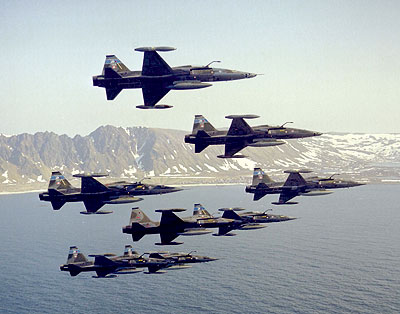
DND photo PCN77-118 CD 108 IMAGE 0056
Air to air view of eight CF-5 aircraft from 434 Squadron, flying in formation over the Norwegian coast.
Conclusions
As presented in this article, the selection of the CF-5 needs to be viewed through the lens of Hellyer’s opinions on the efficacy of air power. It also needs to be assessed in the context of the fiscal and defence policies of the Liberal Party, the argument over the nuclear strike and conventional attack roles, and contemporary air power theory and nuclear strategy. Fundamentally, Hellyer viewed any air power role that relied principally upon nuclear weapons as being completely out of touch with Canadian defence policy. This was especially germane in light of the Liberal government’s changed defence priorities, which relegated its commitment to NATO to third place behind national sovereignty and the defence of North America.
In stark contrast to the views of many of his senior uniformed staff, Hellyer viewed Bill C-243 and the dissolution of the three military services, including the RCAF, as a step forward for Canada’s armed forces. A more flexible and mobile integrated armed forces unit was as much an expression of national independence as it was the beneficiary of increased efficiencies. Although Hellyer and the Liberal Party appeared to be advocates of the American theory of Flexible Response, on a strategic level they were attempting to build an armed forces that was not entirely dependant upon two collective alliances, NATO and NORAD, both of which were dominated by the Americans. John Gellner struck this nationalistic chord when he wrote: “The readiness to follow the leader made us [Canadians] accept the nuclear strike-reconnaissance role for the RCAF’s No.1 Air Division under NATO and its re-equipment with the CF-104 Starfighter.”47 Gellner felt that RCAF leadership during the postwar period had displayed no independent air power thinking and had merely followed the lead of the Americans. Although this conclusion has few proponents today, and it ignores the reality that the choice to use nuclear weapons was consistent with Canadian foreign policy at the time – and not one born out of a perceived need to please the United States – it held a contemporary appeal to a Canadian nationalistic constituency critical of all things American.48
Liberal defence policy called for tactical air power that was sufficiently mobile and flexible, and would therefore, it was believed, serve a more useful purpose. Such an air force was felt to be more appropriate for a country of Canada’s stature, since it would be used more frequently to help bring an end to the numerous smaller conflicts that were occurring around the globe at the time. These conflicts were characterized by the use of conventional, and not nuclear, weapons. The essence of this argument was that an air force built for conventional operations was more likely to be employed than one that was tied to the nuclear role.49
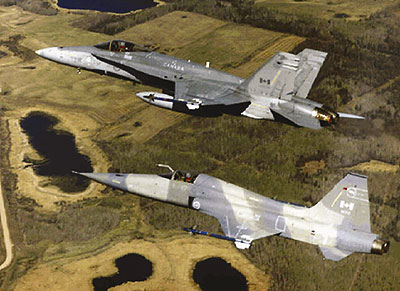
DND photo
Late in its service life, a CF-5 in low visibility markings formates on a CF-18 Hornet.
In shifting its main military effort to the creation of a mobile force designed for use in limited non-nuclear conflicts, the Liberal government felt air power was first to be used strategically to get the necessary force to the theatre of operations, then tactically to do the required job once in theatre.50 The problem in 1968-69 was that Canada possessed neither a suitable tactical fighter capability nor sufficient strategic sea/airlift to meet the demands of the Liberal Party’s defence policy. The planned four squadrons of CF-5s never materialized, due to cuts made to the defence budget by the Trudeau government. Two operational fighter squadrons, primarily equipped with the single-seat CF-5A, were ultimately formed at CFB Bagotville (433 Squadron) and CFB Cold Lake (434 Squadron) respectively. By 1970, however, 74 of the total 115 CF-5s produced had been earmarked for storage, to be flown on a rotational basis, used as attrition aircraft, and, as was the case with a substantial number of them, sold to the Venezuelan Air Force as surplus to needs. Many of the two-seat CF-5Ds disappeared into the pilot training system, serving first as a replacement advanced trainer for the T-33 Silver Star, then later as a third CF-5 unit, 419 Squadron based at CFB Cold Lake. This unit became the official Operational Training Unit for the CF-5 fleet and also provided a vehicle for fighter lead-in training for pilots advancing on to the CF-104 Starfighter, and then later, the CF-18 Hornet.
By the time the first Freedom Fighter rolled out of the Cartierville plant on 6 February 1968, with the subsequent announcement that many of these aircraft would end up in storage, Hellyer had already stepped down as Minister of National Defence. But it is difficult to imagine if Hellyer could have done any more than his successor, Léo Cadieux, in preventing the eventual cuts to the CF-5 fleet, given Trudeau’s popularity and public support for defence reductions at the time.
The lack of funding support aside, the CF-5 was never a popular choice with airmen, particularly for use in Europe.51 In June 1969, the staff of the Vice-Chief of the Defence Staff (VCDS) rejected it as a replacement for the CF-104, due to its many operational limitations.52 In 1970, the operational CF-5s were tasked to deploy to Norway as part of a changed Canadian role in support of NATO’s northern flank. In October of that year, 434 Squadron sent six CF-5s to 4 Wing at Baden Söllingen in Germany via the old refuelling stops eastward from Goose Bay, Labrador to Greenland to Iceland. However, to get to Europe in a timely fashion with a credible weapons load, the CF-5 required a strategic tanker, and the purchase of strategic air-to-air refuelling aircraft was then still several years away. Finally, on 6 June 1973, four Freedom Fighters from each of 433 and 434 Squadrons flew from Canada to Norway non-stop behind a 437 Squadron Boeing 707 tanker on Exercise Long Leap 1, in what turned out to be a flawless trip. Later, such deployments would become relatively routine.
Paul Hellyer and the Liberal Party were uncomfortable with the nuclear role in NATO because they felt it limited the country’s foreign policy options, ignoring the argument that this capability was a tangible contribution to the maintenance of peace in Europe, and, by extension, a contribution to global stability. John Gellner, the most vociferous exponent of Hellyer’s views on air power, was convinced that the Canadian Forces, post-1967, would be “moving from the shadows and reaching out for maturity and independence” by concentrating on conventional attack, as opposed to nuclear strike roles.53 Unfortunately for Hellyer and Gellner, their recommended air power concept, underpinned as it was by mobile conventional forces, was stillborn from the beginning because the Trudeau government never procured the resources necessary to have the concept implemented. What remained was a policy-capability gap that continues somewhat to this day.
In view of the current major force structure changes occurring in DND that bear resemblance to Hellyer’s more mobile and flexible Canadian armed forces, Paul Hellyer’s unilateral means of achieving his objectives may be viewed in a somewhat more positive light. But the selection and limited employment of the CF-5 Freedom Fighter exemplified the consequences of matching well-intentioned political ends with means that ignored professional military advice. In terms of Canada’s Cold War air power capability, Hellyer succeeded in sustaining a national aircraft industry in two key provinces, but the Canadian military was ultimately left with an aircraft in search of a viable role.
![]()
Doctor Stouffer, a serving air force logistics officer, teaches history at the Royal Military College of Canada.
Notes
- Interview with Bill Johnston, 29 May 2006. Mr. Johnston was the Senior Project Manager for the CF-5 Program, 1965-71, working for the Department of Defence Production/Supply and Services Canada.
- File entitled: “NATO 1963, Air Division in Europe – Equipment”, undated, Volume 74, DND, Hellyer Fonds, MG32-B33, National Archives Canada (NAC).
- Paul Hellyer, Damn the Torpedoes: My Fight To Unify Canada’s Armed Forces, (Toronto: McClelland & Stewart, 1990), p. 73.
- Ibid., pp. 73-75.
- Ibid., pp. 19-20.
- “Because we [the Liberal Party] advocate the build-up of NATO strongly by conventional weapons ...we recommend the cancellation of the CF-104 and the abandonment of Canada’s offensive role, and suggest instead that the Canadian Air Division in Europe play a ground support role, providing cover and tactical support to this country’s brigade group. Victoria Columnist, dated 20 November1960. Hellyer correspondence, File 73/1223, Raymont Papers, Series 9, Box 3158, Directorate of History and Heritage (DHH).
- John Gellner was born in Czechoslovakia in 1907 and practised law in that country until coming to Canada in 1939. He joined the RCAF in April 1940 and served as an air observer and then a pilot, which included a tour in Bomber Command. Before his retirement in 1958, he was an instructor at the RCAF Staff College, where he began his writing career on military affairs. Many of his views on air power can be found in his columns written for Canadian Aviation magazine.
- Howard H. Lentner, “Foreign Policy Decision Making: The Case of Canada and Nuclear Weapons”, World Politics 29 (October 1979), pp. 34-35.
- Howard H. Lentner, telephone interview with Paul Hellyer, 19 June 1975, in Lentner, “Foreign Policy Decision Making..., p. 35.
- John Gellner, “Paper Promises RCAF New Blood,” Canadian Aviation, Vol. 37, No.5 (May 1964), p. 32.
- Ibid.
- Hellyer, p. 24
- Douglas L. Bland, Canada’s National Defence, Volume 2: Defence Organization, (Kingston: School of Policy Studies, Queen’s University, 1999), pp. 120-131.
- Quoted in Memorandum to Cabinet, dated 22 October 1969, File 73/1223, Raymont Papers, Series 1, Box 42 (DHH).
- Memorandum from ACM Miller to MND, dated 14 September 1964, File 73/1223, Raymont Papers, Series 1, File 214 (DHH).
- Ibid., p. 2.
- Ibid.
- Hellyer, pp. 114-115.
- Air Staff/COR recommendation, made April 1963, called for the purchase of 288 F-4C Phantom II aircraft at a cost of $836,733,000 (all costs), with the first aircraft delivered December 1965, and the last on 1 December 1968, RG 2 Volume 2749 (NAC).
- Memorandum to Cabinet, “National Defence Equipment Programmes, 1965-6 to 1969-70, Inclusive,” dated 16 November 1964, RG 2 Volume 2749 (NAC).
- Hellyer, pp. 130-131.
- Interview with Dr. Michael Hennessy, Royal Military College, January 2005. Views by Dr. Hennessy based upon review of Liberal Cabinet Papers from 1964.
- Memorandum from Paul Hellyer to ACM Miller, “Selection of a Tactical Aircraft,” dated 20 October 1964, File 73/1223, Raymont Papers, Series 5, Box 2501 (DHH).
- Ibid., p. 2
- Ibid.
- Stuart E. Soward, Hands to Flying Stations, Volume II (Victoria: Neptune Developments, 1995), pp. 264-270.
- Memorandum from Lieutenant-General Allard to MND, through CDS, “Selection of a Tactical Aircraft,” dated 15 February 1965, File 73/1223, Raymont Papers, Series 5, Box 2501 (DHH).
- Hellyer, p. 131.
- Ibid.
- Johnston interview, 29 May 2006.
- Douglas L. Bland, Chiefs of Defence: Government and the Unified Command of the Canadian Armed Forces, (Toronto: The Canadian Institute of Strategic Studies, 1995), p. 75.
- Memorandum from Hellyer to CDS, “Selection of a Tactical Aircraft”
- Anonymous “CF-5 History of Events, 1964-1971”, page A1, paragraph 8, File 73/1223, Raymont Papers, Series 5, Box 2501 (DHH).
- Canadair was coming to the end of its production line of 340 Starfighters for the RCAF and the Mutual Aid Program, and, therefore, was a political force in “looking for more work.” Johnston interview, 29 May 2006.
- Ibid.
- Memorandum from ACM Miller to Mr. Drury, “Implications of Tactical Aircraft Selection,” dated 7 July 1965, File 73/1223, Raymont Papers, Series 5, Box 2501 (DHH).
- “CF-5 History of Events, 1964-1971”, page A3, paragraph 8, File 73/1223, Raymont Papers, Series 5, Box 2501 (DHH).
- Ibid., p. 122.
- Ibid., pp. 121-122.
- Douglas L. Bland, Canada’s National Defence, Volume I, Defence Policy, (Kingston: Queen’s School of Policy Studies, 1997), pp. 58-60.
- Roy Rempel, Counterweights The Failure of Canada’s German and European Policy, 1955-1995, (Montreal, McGill-Queen’s University Press, 1996), p. 124.
- Air Staff Minute Hellyer Fonds, File entitled: “NATO 1963, Air Division in Europe – Equipment”, MG32-B33, Volume 74 (NAC).
- Ibid.
- Letter to Pearson by George Drew, dated 8 October 1963, DND, Hellyer Fonds, File entitled: “NATO 1963, Air Division in Europe – Equipment”, MG32-B33, Volume 74 (NAC).
- Minutes of the 176th Meeting of the Air Staff Policy Committee, Item 1, paragraph 13, held 6 February 1964, File 76/263 (DHH).
- Ibid.
- John Gellner, “Canadian Air Power – at the Beginning of a New Era”, Canadian Aviation, (February 1968), p. 15.
- See D.W. Middlemiss and J. Sokolsky, Canadian Defence: Decisions and Determinants, (Toronto: Harcourt Brace Janovich Canada, 1989), p. 61.
- Gellner, “Canadian Air Power – at the Beginning of a New Era,” p. 16.
- Ibid.
- In e-mails received on 22 October 2004, opinions solicited from veteran strike pilots about the CF-5 were for the most part derisive.
- See “CF-5: History of Events”, page F-8, paragraph 17(c), File 73/1223, Raymont Papers, Series V, Volume 2501 (DHH).
- Gellner, “Canadian Air Power – at the Beginning of a New Era,” pp. 14-15.
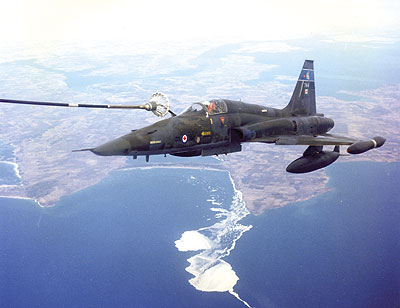
DND photo
A CF-5 from 434 Bluenose Squadron getting topped up with fuel.






